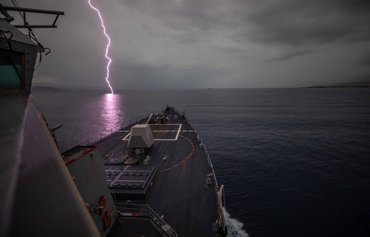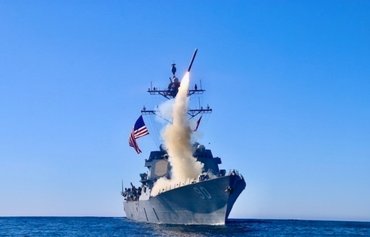The US Navy's Arleigh Burke-class destroyers, with their multi-mission offensive and defensive capabilities, have proven for decades to be successful in a variety of scenarios, including air, surface and subsurface warfare.
The destroyers are able to strike moving targets on land using Tomahawk cruise missiles; take out submarines using towed sonar array, rockets and helicopter strikes; and destroy ships using the Harpoon anti-ship missile.
The Tomahawk cruise missile is a long-range, all-weather, subsonic missile with a range of up to 1,600km and the ability to fly at extremely low altitudes to avoid detection by enemy radar.
The missile is equipped with a range of guidance systems, which allow it to navigate to its target with extreme accuracy.
![US Navy personnel load a high calibre gun onboard an Arleigh Burke destroyer during a live fire exercise in March. [US Navy]](/cnmi_am/images/2023/04/08/41564-arleigh-burke-600_384.jpg)
US Navy personnel load a high calibre gun onboard an Arleigh Burke destroyer during a live fire exercise in March. [US Navy]
![The USS Arleigh Burke, the lead ship of the Arleigh Burke-class guided-missile destroyers, is shown in an undated photo. [US Navy]](/cnmi_am/images/2023/04/08/41563-navy-600_384.jpg)
The USS Arleigh Burke, the lead ship of the Arleigh Burke-class guided-missile destroyers, is shown in an undated photo. [US Navy]
It is capable of carrying a range of warheads, and can be programmed to attack a range of targets, including enemy air defence systems, command and control centres, communication facilities and other high-value targets.
The missile is capable of penetrating enemy air defences, making it a valuable weapon in a variety of scenarios.
Seeing service around the world
The United States first used the Tomahawk in combat in Iraq in 1991. It has been subsequently used in Bosnia (1995), Libya (1996 and 2011), Sudan (1998), Yemen (2009), and Afghanistan (1998 and 2001-2021).
The missile saw use in the fight against the "Islamic State of Iraq and Syria" (ISIS) and in the Syrian civil war.
The United States fired dozens of Tomahawk missiles in April 2017 in response to a chemical attack by the Syrian military on the opposition-held city of Khan Sheikhoun.
Arleigh Burke-class destroyers USS Porter and USS Ross launched a total of 59 Tomahawks against Shayrat air base. They targeted aircraft, hardened aircraft shelters, petroleum and logistical storage, ammunition supply bunkers, air defence systems and radars.
Arleigh Burke-class destroyers can carry more than 90 Tomahawk missiles.
The ships are also equipped with the Aegis Combat System and Standard Missile 3 (SM-3) and Standard Missile 6 (SM-6) surface-to-air missiles for ballistic missile defence.
In addition to its missile systems, the Arleigh Burke-class destroyer is equipped with a range of guns and other weapons systems, which are capable of engaging both air and surface targets.
Finally, the ship carries torpedoes and anti-submarine rockets for engaging submarines and other underwater threats.
Versatile vessel
Another key capability of the Arleigh Burke-class destroyer is its ability to operate in a variety of environments.
The ship is equipped with a variety of sensors and systems that allow it to operate in shallow water and close to shore, as well as in deep water.
The destroyer is also equipped with a range of electronic warfare systems, which allow it to detect and counter enemy electronic systems.
These systems can jam enemy radar and communications systems and can lure enemy torpedoes away from the ship.
One of the principal capabilities of the Arleigh Burke-class destroyer is its ability to operate as part of a carrier strike group.
The ship is designed to work closely with other ships in the strike group, including aircraft carriers, cruisers and other destroyers. It can provide air defence for the strike group, as well as engage enemy targets with its own weapon systems.
In addition to its offensive and defensive capabilities, the Arleigh Burke-class destroyer is equipped with a range of support systems, including a helicopter hangar and flight deck for operating anti-submarine helicopters, such as the MH-60 Seahawk helicopter, and other aircraft.
In recent years, Arleigh Burke destroyers have been instrumental in maritime interdiction and security operations, supporting maritime stability through counter-narcotics and counter-weapon-smuggling operations, especially in the Red Sea.
In the summer of 2022, the US Navy ordered two more Arleigh Burke-class destroyers to be based at Rota, Spain, joining four others already based there.
Basing the destroyers at Rota gives them the flexibility to operate throughout the waters of Europe and Africa, from the Cape of Good Hope to the Arctic Circle, according to the US Navy.

![An Arleigh Burke-class destroyer launches a Tomahawk cruise missile. [US Navy]](/cnmi_am/images/2023/04/08/41565-tomahawk-600_384.jpg)







Thank you
Reply2 Comment(s)
Thanks!
Reply2 Comment(s)